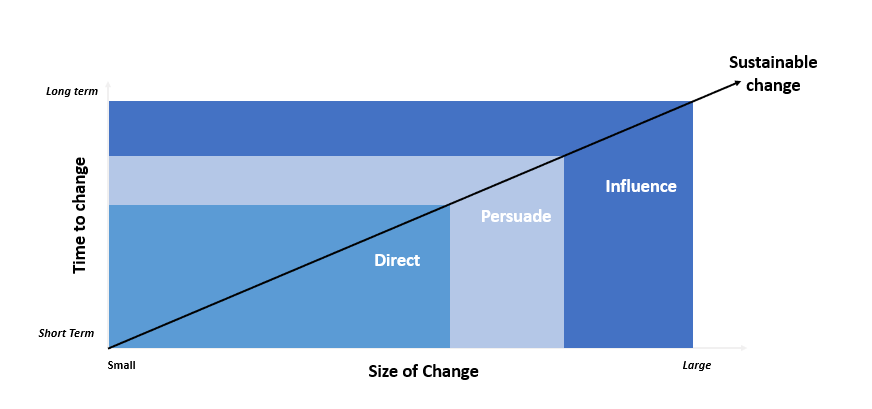Leading That Lasts the Test of Time

So often the role of the leader is to make a change. This might be in response to external influences, such as the unprecedented pressures of recent times. Or it could be due to the need to change behaviour to achieve the strategic vision an organisation needs to thrive. Either way, leading change is integral to delivering success.
It seems sensible, then, to take a closer look at how we, as leaders, can effect change. In this blog, I’ll be unpicking the differences between directing, persuading and influencing. All three approaches have their place, of course. But knowing why you’re using each one is useful.
For example, directing people (with specific instructions) can get results quickly. But these results can be short-lived. Persuading people – with nudges and encouragement – can help to generate a bigger shift over a longer period. But it’s only influencing people – so they share and follow a shared vision – that builds and supports real change over the long term.

Recognising when you’re directing, persuading or influencing is a good sign of self-awareness in a leader. A key quality that suggests you understand not just the change you want to see, but how you want to make it. This is hard work. There will be setbacks, times in which teams fall back into old behaviours. This is natural, and to be expected; this is where true leadership comes into place to coach and help teams through change.
The evolution of a manager
Direct, persuade or influence? The right technique will depend on a leader’s level, how quickly they need to see an impact and the size of the change that they are trying to achieve. It also had a strong dependence on the maturity of your team and the willingness to step up.
Picture a first-line manager. Their job is to make sure tasks are carried out. And their reports are looking for clear instructions. So, they typically focus their efforts on direction – to drive tactical changes in a quick way. This is effective, but the direction takes up a lot of their time and effort.
What of the second-line manager? They’re managing managers. So, they might be asking someone else to develop a high performer or feeding back on how to make use of resources. While they advise on how to do this, they stop short of telling people exactly what to do. Instead, they need to rely on their persuasive skills: conveying objective reasons why, to encourage others to deliver on the plan.
As a manager progresses to an executive role (becoming a third- or fourth-line manager), they’re faced with the job of creating larger, strategic changes over a longer-term. And they have to do it with less time with any one individual. This makes influencing the only viable way to sustainably drive change. It simply isn’t practical to direct everyone. Instead, leaders need to explain why change needs to happen, to create advocates. Then, they need to communicate this why consistently and clearly, so that it makes sense to individual contributors.
For senior leaders, there’s also the need to influence people outside of the organisation. Analysts, customers, partners and the press. They don’t work for you, so you lack the tools to persuade them. But you can get them to buy into your vision through creating a relationship, sharing your ideas and operating with a high say/do ratio to build trust over time. The importance of a shared vision is key here including a set of strategies that cascade all the way through the organisation.
Becoming an influencer
It’s clear, then, why leaders are attracted to an influencing model. But what are the traits of influencing? And how can we tell when we’re influencing positively? Below, I’ve brought together a few questions I regularly ask myself to see if I’m influencing, rather than persuading or directing.
Are you showing why?
If you want people to get behind a vision, they need to know what it is and why it’s a good idea. A clear and consistent message on the team or company’s purpose therefore goes a long way. You can also use objective data to strengthen your case. This might be a way of demonstrating progress. But if progress is slow, it’s important to avoid messaging results with selected reality. This could damage trust in what you are saying. And trust is a prerequisite if you want people to support and follow you.
Are you getting others to say how?
While you’re busy focusing on the why, let others explain how. Even as leaders become quite senior, people will continue to bring them problems. By all means, solve things and make decisions. But instead of routinely telling your team how, help them work it out. If someone gets to the conclusion themselves, they’re more invested in the outcome.
Practising powerful questions can help. This can mean resisting the urge to ask how and focusing on the more pointed questions of why and what.

Another part of helping others work things out for themselves is careful listening. What is someone really trying to tell you? What are they not seeing? Influencing might put one in mind of talking and convincing. But the most effective influence starts with good listening and good questions. I think listening is critical, but also encouraging ongoing engagement through the change process, peer to peer, manager to employee. As engagement goes up so does the chance that the change will be successful. If you co-create the change with your teams they feel ownership, empowered and will help you lead to your new destination. In my mind, that’s the hidden secret.
Are you leading by example?
People are what they see. And a leader is an influence, naturally. They’re the person who sets direction, they’re a spokesperson, and they’re the example to others in the organisation.
In their excellent book, Mankins and Garton identify the time, talent and energy of people as the most valuable resource today.[1] So, as a leader, where are you putting yours? And how are you helping others use their time, talent and energy?
Asking this question and getting to the answer rests on self-awareness. And the amazing thing about being self-aware as a leader is that it breeds self-awareness in others. (You can read more about this in my previous blog.)
Are you shaping the right culture?
Even with the right purpose and team, there’s still the question of attitude and behaviour. Is your influence helping to build the culture that will support the goal of the business (and promote its values)? Do you treat people equally and celebrate all functions? Do you work with people, so everyone feels they can contribute? All these things can help to create an open environment.
If you’re influencing others to act in a way that’s conducive to the success of the business, it’s likely that you’ll want to see a learning culture too. This is where individuals adopt a learn-practice-teach cycle, to keep growing and share knowledge. Are the opportunities in place for people to educate themselves and others?
Influence and change management
If influencing is the most effective way to lead fundamental change, it provides a way to measure progress. Are you able to influence? Or are you getting dragged back into persuading or directing again and again? For example, you might find yourself reconfirming what people are doing all the time, or just talking tactics in one-to-ones. This could be a sign that you’re not painting a clear enough picture of people’s roles or the vision. Or it could be a sign that someone is challenging your view. This can help a leader to troubleshoot and get back on track.
Ultimately, humans have multi-layered motivations – from self-interest to a commitment to a cause or community. So, leaders will deploy different techniques to steer behaviour over their career. But an influencer model is far and away the most efficient means of achieving more sustainable and more substantive change.
If you’ve got further thoughts on the role of influence in leading change, I’d be keen to hear them. Please add a comment below.
